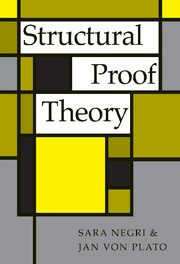Book contents
- Frontmatter
- Contents
- PREFACE
- INTRODUCTION
- 1 FROM NATURAL DEDUCTION TO SEQUENT CALCULUS
- 2 SEQUENT CALCULUS FOR INTUITIONISTIC LOGIC
- 3 SEQUENT CALCULUS FOR INTUITIONISTIC LOGIC
- 4 THE QUANTIFIERS
- 5 VARIANTS OF SEQUENT CALCULI
- 6 STRUCTURAL PROOF ANALYSIS OF AXIOMATIC THEORIES
- 7 INTERMEDIATE LOGICAL SYSTEMS
- 8 BACK TO NATURAL DEDUCTION
- CONCLUSION: DIVERSITY AND UNITY IN STRUCTURAL PROOF THEORY
- APPENDIX A SIMPLE TYPE THEORY AND CATEGORIAL GRAMMAR
- APPENDIX B PROOF THEORY AND CONSTRUCTIVE TYPE THEORY
- APPENDIX C PESCA – A PROOF EDITOR FOR SEQUENT CALCULUS (by Aarne Ranta)
- BIBLIOGRAPHY
- AUTHOR INDEX
- SUBJECT INDEX
- INDEX OF LOGICAL SYSTEMS
CONCLUSION: DIVERSITY AND UNITY IN STRUCTURAL PROOF THEORY
Published online by Cambridge University Press: 25 February 2010
- Frontmatter
- Contents
- PREFACE
- INTRODUCTION
- 1 FROM NATURAL DEDUCTION TO SEQUENT CALCULUS
- 2 SEQUENT CALCULUS FOR INTUITIONISTIC LOGIC
- 3 SEQUENT CALCULUS FOR INTUITIONISTIC LOGIC
- 4 THE QUANTIFIERS
- 5 VARIANTS OF SEQUENT CALCULI
- 6 STRUCTURAL PROOF ANALYSIS OF AXIOMATIC THEORIES
- 7 INTERMEDIATE LOGICAL SYSTEMS
- 8 BACK TO NATURAL DEDUCTION
- CONCLUSION: DIVERSITY AND UNITY IN STRUCTURAL PROOF THEORY
- APPENDIX A SIMPLE TYPE THEORY AND CATEGORIAL GRAMMAR
- APPENDIX B PROOF THEORY AND CONSTRUCTIVE TYPE THEORY
- APPENDIX C PESCA – A PROOF EDITOR FOR SEQUENT CALCULUS (by Aarne Ranta)
- BIBLIOGRAPHY
- AUTHOR INDEX
- SUBJECT INDEX
- INDEX OF LOGICAL SYSTEMS
Summary
COMPARING SEQUENT CALCULUS AND NATURAL DEDUCTION
Structural proof theory was born in two forms, natural deduction and sequent calculus. The former has been the more accessible way to proof theory, used in teaching. The latter, instead, has yielded better to structural proof analysis. For example, the underivability results for intuitionistic predicate logic in Section 4.3 were obtained for sequent calculus in the early 1950s.
Even if natural deduction gives the easier access, in the end proofs are easier to find in sequent calculus. It formalizes the analysis into subgoals of the theorem to be proved, whereas in natural deduction this has to be done intuitively.
Furthermore, the sequent calculi we studied in Chapters 2–4, with their shared contexts in two-premiss rules, support root-first proof search.
With independent contexts, we found sequent calculi that come very close to natural deduction, especially if in the latter general elimination rules are used. One essential difference, the presence in sequent calculus of explicit rules of weakening and contraction, was overcome by a suitable change of the logical rules of sequent calculus to permit implicit weakening and contraction similarly to natural deduction. Then cut-free proofs in sequent calculus and normal proofs in natural deduction became mere notational variants of one and the same proof. Isomorphic translation turned the sequent calculus derivation with its locally applied rules into a standard nonlocal natural deduction derivation. One difference between the two types of calculi remained: Where the logical rules of natural deduction admit of non-normal instances, sequent calculus uses a logical rule and a cut. It is a cut with the cut formula principal in at least the right premiss.
- Type
- Chapter
- Information
- Structural Proof Theory , pp. 211 - 218Publisher: Cambridge University PressPrint publication year: 2001



